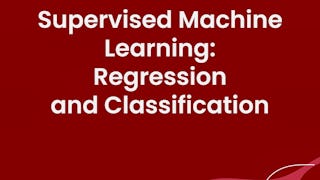This course introduces you to one of the main types of modelling families of supervised Machine Learning: Regression. You will learn how to train regression models to predict continuous outcomes and how to use error metrics to compare across different models. This course also walks you through best practices, including train and test splits, and regularization techniques.

Enjoy unlimited growth with a year of Coursera Plus for $199 (regularly $399). Save now.

Supervised Machine Learning: Regression
This course is part of multiple programs.



Instructors: Mark J Grover
76,126 already enrolled
Included with
(815 reviews)
Skills you'll gain
Details to know

Add to your LinkedIn profile
See how employees at top companies are mastering in-demand skills

Build your subject-matter expertise
- Learn new concepts from industry experts
- Gain a foundational understanding of a subject or tool
- Develop job-relevant skills with hands-on projects
- Earn a shareable career certificate

There are 6 modules in this course
This module introduces a brief overview of supervised machine learning and its main applications: classification and regression. After introducing the concept of regression, you will learn its best practices, as well as how to measure error and select the regression model that best suits your data.
What's included
11 videos3 readings3 assignments2 app items
There are a few best practices to avoid overfitting of your regression models. One of these best practices is splitting your data into training and test sets. Another alternative is to use cross validation. And a third alternative is to introduce polynomial features. This module walks you through the theoretical framework and a few hands-on examples of these best practices.
What's included
7 videos1 reading3 assignments2 app items
There is a trade-off between the size of your training set and your testing set. If you use most of your data for training, you will have fewer samples to validate your model. Conversely, if you use more samples for testing, you will have fewer samples to train your model. Cross Validation will allow you to reuse your data to use more samples for training and testing.
What's included
6 videos1 reading2 assignments2 app items1 plugin
This module walks you through the theory and a few hands-on examples of regularization regressions including ridge, LASSO, and elastic net. You will realize the main pros and cons of these techniques, as well as their differences and similarities.
What's included
10 videos1 reading3 assignments1 app item
In this section, you will understand the relationship between the loss function and the different regularization types.
What's included
5 videos1 reading2 assignments2 app items
In this assignment, you will apply regression techniques to analyze a dataset of your choice. Your task is to preprocess the data, build and compare models, extract insights, and suggest next steps.You will focus on presenting key findings and insights—not the code. You may include visuals to support your analysis, but the report should be a clear summary of your process and conclusions.Your final report will be evaluated by an AI graded tool.
What's included
3 readings2 app items
Earn a career certificate
Add this credential to your LinkedIn profile, resume, or CV. Share it on social media and in your performance review.
Instructors



Offered by
Explore more from Machine Learning
 Status: Free Trial
Status: Free Trial Status: Free Trial
Status: Free Trial Status: Free Trial
Status: Free Trial Status: Free Trial
Status: Free TrialDeepLearning.AI
Why people choose Coursera for their career




Learner reviews
815 reviews
- 5 stars
77.05%
- 4 stars
17.42%
- 3 stars
3.19%
- 2 stars
1.10%
- 1 star
1.22%
Showing 3 of 815
Reviewed on Jan 6, 2022
Linear Regression, Ridge, Lasso, Elastic Net, L1 and L2 regularizations... All very well explained theoretically and coded on Jupyter Notebook accordingly.
Reviewed on Nov 6, 2020
Great course and very well structured. I'm really impressed with the instructor who give thorough walkthrough to the code.
Reviewed on Aug 10, 2021
Well structured course. Concepts are explained clearly with hands on exercises.

Open new doors with Coursera Plus
Unlimited access to 10,000+ world-class courses, hands-on projects, and job-ready certificate programs - all included in your subscription
Advance your career with an online degree
Earn a degree from world-class universities - 100% online
Join over 3,400 global companies that choose Coursera for Business
Upskill your employees to excel in the digital economy
Frequently asked questions
To access the course materials, assignments and to earn a Certificate, you will need to purchase the Certificate experience when you enroll in a course. You can try a Free Trial instead, or apply for Financial Aid. The course may offer 'Full Course, No Certificate' instead. This option lets you see all course materials, submit required assessments, and get a final grade. This also means that you will not be able to purchase a Certificate experience.
When you enroll in the course, you get access to all of the courses in the Certificate, and you earn a certificate when you complete the work. Your electronic Certificate will be added to your Accomplishments page - from there, you can print your Certificate or add it to your LinkedIn profile.
More questions
Financial aid available,
¹ Some assignments in this course are AI-graded. For these assignments, your data will be used in accordance with Coursera's Privacy Notice.

